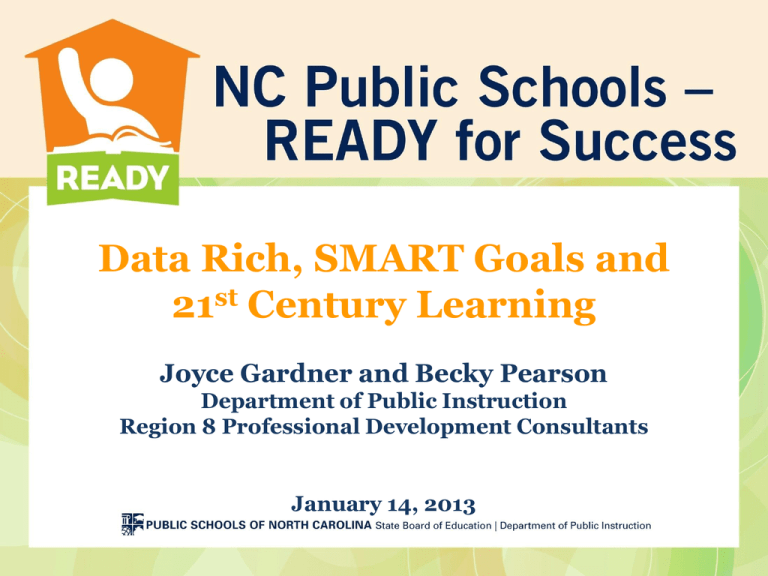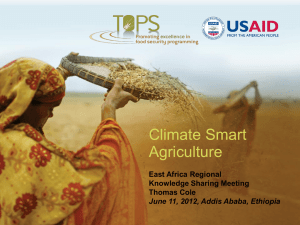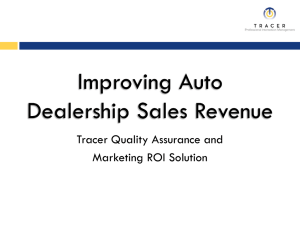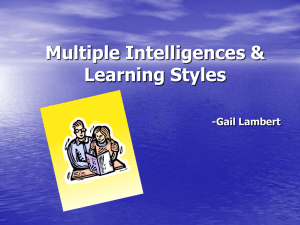SMART Goals for 21st Century Learning Rosman
advertisement

Data Rich, SMART Goals and 21st Century Learning Joyce Gardner and Becky Pearson Department of Public Instruction Region 8 Professional Development Consultants January 14, 2013 Region8wnc.ncdpi.wikispaces.net Outcomes • To fine-tune skills in writing and assessing SMART Goals for 21st century teaching and learning • To reference the NC Educator Evaluation System Teacher Pre-assessment in the development of powerful SMART Goals • To build SMART Goals into the Professional Development Plan 21st Century Classrooms: Dan Meyer After you view the video, respond to the following questions regarding 21st century learning. • Which aspects of teaching and learning in your classroom reflect the traditions of education of the past? • Which aspects of teaching and learning for the 21st century have you incorporated in your instructional practice? • Which components of 21st century teaching and learning are most challenging for you? http://www.ted.com/talks/lang/en/dan_meyer_math_curriculum_makeover.html Treasure Hunt http://goo.gl/sJszB Six-Step Partners http://goo.gl/Vb2g8 PLCs • Do PLCs meet to study tools, resources and documents to support the teaching and learning of the new Standard Course of Study? • How is the work of PLC’s documented? Tools and Processes • What tools and processes are in place to gauge and support the needs of teachers as they learn and prepare to teach the new Standard Course of Study? (walkthroughs, surveys, conferencing, etc.). Technology • What improvements and advances in technology have been implemented in your schools to transform your classrooms and instructional practices into 21st century learning environments? Data Literacy • What evidence proves that each of us is data literate? What data do we use to inform instruction, make 21st century school decisions or determine which programs really impact student learning? • How do we move toward distinguished on the evaluation tool in data literacy? SMART pecific and Strategic easurable ttainable and achievable esults-oriented ime-bound Elements of an Effective Professional Development Plan SMART Goals (2-3) wellwritten and supported by data Feedback from administrator Thorough selfassessment SMART Goal Setting in the Online Tool Rollover Professional Development Plan (Teachers with Summary Rating Form from Previous Year) Preliminary Professional Development Plan (Teachers new to online tool system) SMART Goals and Professional Development Plans SMART Goals provide a process for effective goal setting Any existing observations and/or artifacts guide the goal setting SMART Research “Feelings of success in the workplace occur to the extent that people see that they are able to grow and meet job challenges by pursuing and attaining goals that are important and meaningful.” Locke, E. A., & Latham, G. P. (2006). New Directions in Goal Setting Theory. Current Directions in Psychological Science, 15(5), 265-268. Why SMART Goals? Targeted Professional Growth Increased Student Achievement Teacher Greater effort and persistence Motivation to seek new knowledge and information Locke, E. A., & Latham, G. P. (2006). New Directions in Goal Setting Theory. Current Directions in Psychological Science, 15(5), 265-268. SMART Goals Focus on results-oriented goals rather than process-oriented goals. Specific and Strategic • Goals are clearly stated, long-term and aligned with data. Measurable • Results can be determined with quantitative or qualitative measures. Attainable & Achievable • The result can be reached, even if it is a stretch goal. • The goal is worthy of educator commitment of time and effort. Results-oriented • Goals are data driven. • Benchmarks are established for monitoring progress through the year. • High expectations are set for teacher and student growth. Realistic • Constraints on time, people, materials and other resources have been identified. • There is belief this goal is important and can be accomplished. • Benchmark and completion dates set a sense of urgency and establish momentum • Each person involved is accountable for working towards the goal. Data for Setting Goals • Determine greatest area of need • Determine the range of improvement • Review hard and soft data over time What other data can be referenced when goal setting? Range of Improvement 75% of Ms. Gardner’s fifth graders scored proficient or above on the End of Grade Mathematics test while her teammates’ students reach 90-95% proficiency. What would be a reasonable range of increase in percentage for one year for Ms. Gardner? 75% to 85%? 95%? Reasonable? Standard I, Teachers Lead in the Profession: Ms. Baker will assume the lead of 3 Professional Learning Communities (PLCs): Writing, Differentiating Instruction, Revised Bloom’s, AND she will facilitate unit development for the 8th grade ELA team by mid-year (even though she has never been in a school leadership role). Reasonable? Standard I, Teachers Lead in the Profession: Ms. Johnson will attend a 4-session regional lesson study seminar during September and October and lead one Professional Learning Community in lesson study beginning in February 2013 (even though she has never led a PLC). Goal Setting Example increase the math achievement of fifth graders so that the percentage of students who score at or above Level III will increase from 75% to 85% by June 2013 as measured by EOG mathematics data. To: What activities would help this teacher increase students’ success? SMART Goals are . . . . pecific and Strategic easurable ttainable and achievable esults-oriented ime-bound Can you make this goal SMART? By the end of first semester, student office referrals will decrease. Let’s Practice To: Do What? so that Who/What? will increase/decrease by completion date as measured by what data?. By the end of first semester, student office referrals will decrease. To: Do What? so that Who/What? will increase/decrease by completion date as measured by what data?. Work with a partner to revise this statement and make it a SMART Goal. • Write one of your goals based on your pre-assessment for your Professional Development Plan. • Use the SMART Goal Worksheet to refine your goal. SMART Goals Worksheet Gallery Walk • Post your SMART Goals • Visit each SMART Goal and add your suggestions to make them SMARTer! Teacher Process for Completing the Self-Assessment in the Online Tool Before First Formal Observation STEP 2: Step 2: Self Assessment, SelfGoal Setting, and Assessment, Pre-conference Goal Setting and PreConference Component 3: Teacher Self-Assessment Using the Rubric , the teacher shall rate their performance and reflect on his or her performance throughout the year. Component 4: Pre-Observation Conference Before the first formal observation, the principal meets with the teacher to discuss: self- assessment, professional growth plan a written description of the lesson(s) to be observed. Goal: To prepare principal for the observation. Data Points for Teacher Self-Assessment Teacher Summary Rating Form from Previous Year Recent Student Achievement Results Walkthrough Data Differentiated Lesson Plans Teacher Self-Assessment Using the Rubric for Evaluating North Carolina Teachers Teacher completes the document by selecting ratings along the continuum Teacher saves the document in the online system Complete a New Self Assessment Log into the system Click on NCEES icon Click on Observe/Report Click on New Self Assessment Complete a New Self Assessment Use naming convention Click on Next Copy Self Assessment Dropdown Highlighted Text in Green Banner Completing the Self- Assessment Process for Closing the Form Review the document Click on Spell Check Click on Save Click on Done Click on Logout Closing and Reflection • How will you use what you learned today? • What aha’s did you have? Contact Information Joyce Gardner Becky Pearson joyce.gardner@dpi.nc.gov becky.pearson@dpi.nc.gov






